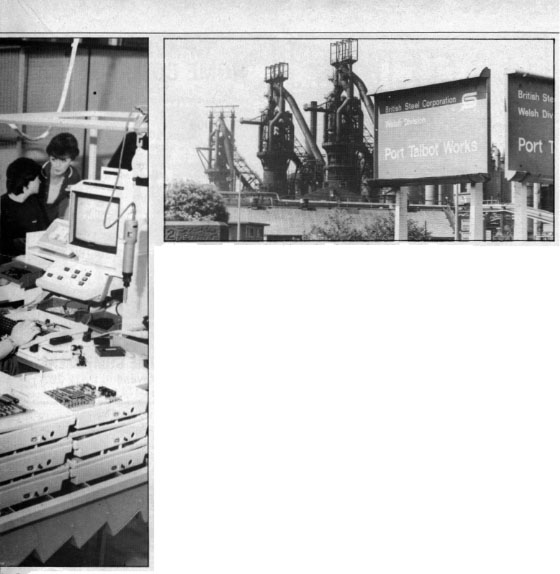
|
Microware software is
already
being used by a wide
range of
customers, including
Eastman
Kodak, General
Electric,
the National Aero-
nautics
and Space Adminis-
tration
(Nasa) and the United
States
Navy. This is the kind
of
company Dragon Data is
joining.
But not
too many Dragon 32
users are
expected to be in-
terested
in the disk drive sys-
tem which
costs under £300 at
entry
level and about £500
with two
drives. Tony com-
mented:
“We think about 10
per cent
of Dragon 32 owners
will take
the double drive op-
tion
— more on the Conti-
nent.”
Demand
abroad for the Dra-
gon is
strong and Tony says:
“It is
fast becoming the big-
gest
selling home computer
on the
Continent.” But he
added:
“It is a different mar-
ket,
with more home owners
using
the machine at work.”
He puts
this down to labour
costs
being higher, so micros
are used
at work to provide
information at little
extra cost. Consolidating
the
new
operating
system’s
launch
The introduction of 0S9 will
be
consolidated with the
launch
of the Dragon 64 in
September Tony is sure
that
“there
is a demand for a small
business
computer that is re-
latively
cheap” and that the 64
will
meet this demand. He
expects
packages including
the
micro, a monitor and
drives
to sell for about £1,100.
The 64
will give 51 columns
by 25
lines on the screen and
will
have an R5232 interface.
The
machine will involve a
retailing change for
Dragon
Data
— some 64s will be sold
through
high street chains like
Boots,
but more are expected
to be
sold by dealers as off-
the-shelf
systems.
An RS232
interface is also a
feature
of the American Dra-
gons
which will be launched
this
summer, costing about
$399, in
partnership with Tano
Corporation of New
Orleans.
Tony
admits: “We’re not ex-
pecting
to sell millions in the
US
because there are a lot of
machines
at that price in the
market.”
But
interest is already high.
He took
the Dragon 32 to an
American
computer show last
April
and about 4,000 dealers
made
enquiries. Only 400-500
dealers
will be involved initial-
ly, but
this will go up to 1,500
as
production rises from a
starting
figure of 2,000 a
week.
The
marketing strategy in
the US
aims to profit from the
pricing
wars being fought
there by
the main manufactur-
ers.
Tony commented: “We
think
dealers will be keen be-
cause
they are losing their
profit
margins.” He added that
he
expects to lure Commod-
ore,
Atari and Texas In-
struments
dealers.
Tano
Corporation, which
has
100,000 square feet of
manufacturing space,
was
chosen
ahead of five other
companies. Its
background is
in
marine automation sys-
tems,
including a lot of experi-
ence
using the 6809 chip on
which
the Dragon 32 is based.
And Tano
already sells
another
micro — an Apple
look-alike designed in
Holland
and
manufactured in Korea.
Among
all this activity, Dra-
gon 32
users are not being
forgotten. While plans
to
launch a
printer have been
shelved,
a cassette recorder
guaranteed to work
with the
Dragon
is due out this sum-
mer.
Tony
explained that “a prin-
ter was
not very likely at the
moment”
because good ones
were
available and the falling
value of
sterling was creating
financial problems
when
buying
from abroad.
Dragon
Data’s other
machines
will also be sold in
the US.
The £400 micro,
so far
without a name, will be a
twin-6809 system
stepping up
the
company’s attack on the
educational and
business
markets.
In addition to 0S9,
the
intention is that it will run
Flex, a
longer established
operating system which
has
more
applications software
available for
it.
At £400
the machine is also
aimed at
the home user, offer-
ing
improved Basic and high
quality
graphics. And it will
break
away from the Dragon
32
mould, looking different to
previous
machines.
While
Tony agrees that
there is
an overlap between
the
machines discussed so
far, he
argues that each has
excellent facilities
in terms of
value
for money. Aiming to achieve
a high
level
of
software
portability
The appearance of next
year’s
micro will again be
different. Retailing
at under
£2,000,
this will offer “a uni-
que bus
structure” giving a
high
level of software portabil-
ity.
Tony added that it will run
“68000-based and
8086-
based
software either indi-
vidually
or both together”.
This
avoids the problem suf-
fered by
early 16-bit users
who
found themselves short of
easily
available software. A lot
of the
development work is
already
finished for this
machine,
which Tony expects
to sell
more of in the US than
in the
UK.
Dragon
Data is expanding
its
present factory to cope with
these
plans and negotiating
with the
Welsh Development
Authority for another
site.
While
Port Talbot’s traditional
employer, the steel
mill, is
struggling, the
microcomputer
manufacturer down the
road is
thriving. •
Port
Talbot ' s traditional employer, me steel mill, is struggiing while Dragon
Data thrives.
July
1983 Dragon User 23 |